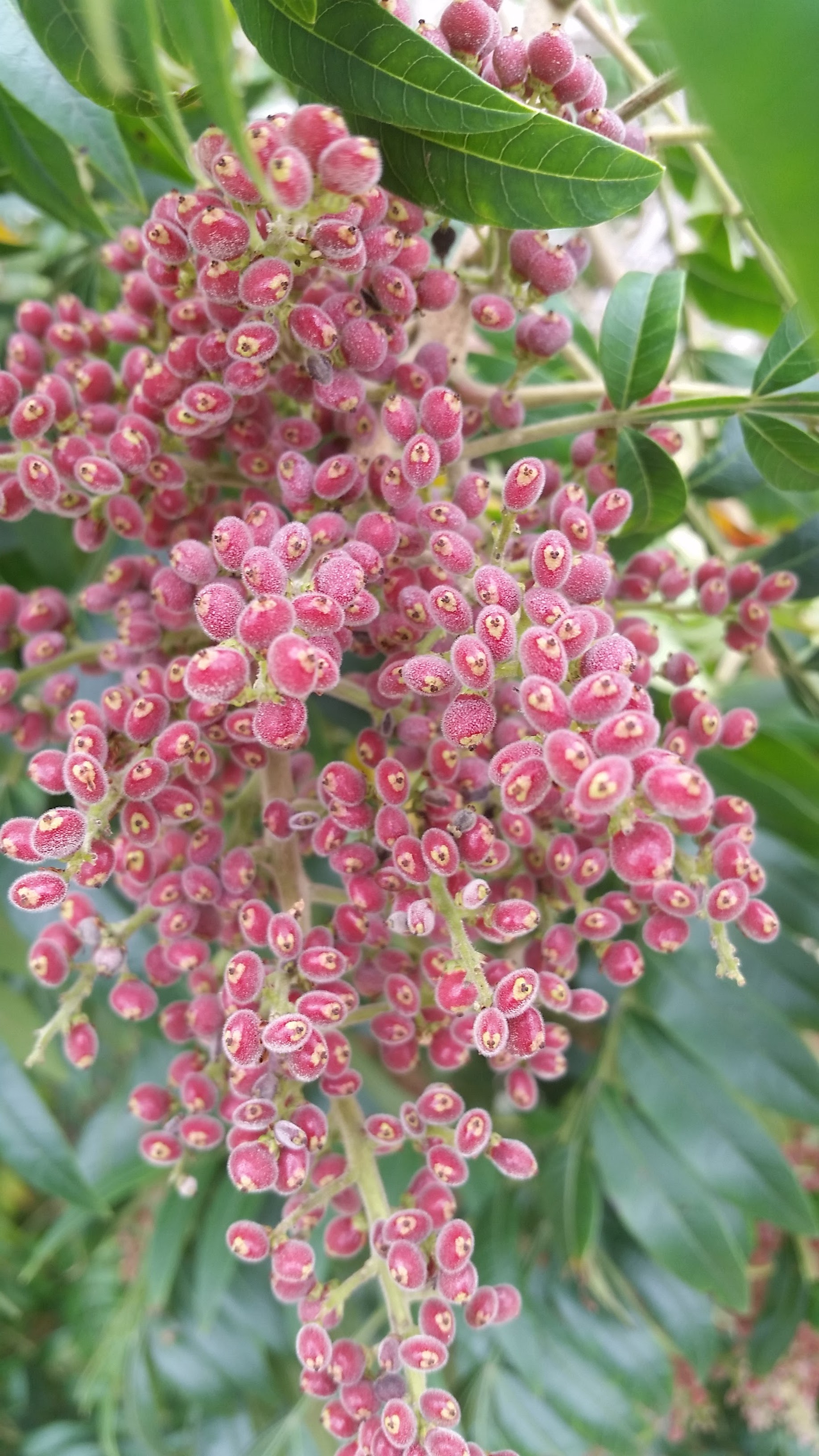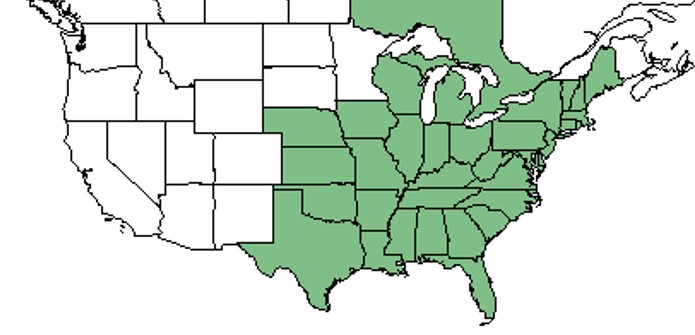Difference between revisions of "Rhus copallinum"
Lsandstrum (talk | contribs) |
Lsandstrum (talk | contribs) |
||
| Line 34: | Line 34: | ||
===Habitat=== <!--Natural communities, human disturbed habitats, topography, hydrology, soils, light, fire regime requirements for removal of competition, etc.--> | ===Habitat=== <!--Natural communities, human disturbed habitats, topography, hydrology, soils, light, fire regime requirements for removal of competition, etc.--> | ||
''R. copallinum'' habitats include old fields, oak-hickory woods, oak scrubs, marsh banks, roadsides, and sand ridges. <ref name="fsu">Florida State University Robert K. Godfrey Herbarium database. URL: [http://herbarium.bio.fsu.edu http://herbarium.bio.fsu.edu]. Last accessed: March 2016. Collectors: Loran C. Anderson, Tom Barnes, Kathy Craddock Burks, G. Fleming, P. Genelle, Robert K. Godfrey, Gary R. Knight. States and Counties: Florida: Florida: Citrus, Franklin, Gadsden, Jackson, Jefferson, Leon, Liberty, St. Johns, Wakulla.</ref> | ''R. copallinum'' habitats include old fields, oak-hickory woods, oak scrubs, marsh banks, roadsides, and sand ridges. <ref name="fsu">Florida State University Robert K. Godfrey Herbarium database. URL: [http://herbarium.bio.fsu.edu http://herbarium.bio.fsu.edu]. Last accessed: March 2016. Collectors: Loran C. Anderson, Tom Barnes, Kathy Craddock Burks, G. Fleming, P. Genelle, Robert K. Godfrey, Gary R. Knight. States and Counties: Florida: Florida: Citrus, Franklin, Gadsden, Jackson, Jefferson, Leon, Liberty, St. Johns, Wakulla.</ref> | ||
| − | ''R. copallinum'' responds positively to agricultural-based soil disturbance in South Carolina coastal plain communities. This marks it as a possible indicator species for post-agricultural woodland.<ref>Brudvig, L.A., E Grman, C.W. Habeck, and J.A. Ledvina. (2013). Strong legacy of agricultural land use on soils and understory plant communities in longleaf pine woodlands. Forest Ecology and Management 310: 944-955.</ref><ref>Brudvig, L.A., J.L. Orrock, E.I. Damschen, C.D. Collins, P.G. Hahn, W.B. Mattingly, J.W. Veldman, and J.L. Walker. (2014). Land-Use History and Contemporary Management Inform an Ecological Reference Model for Longleaf Pine Woodland Understory Plant Communities. PLoS ONE 9(1): e86604.</ref> It responds positively to soil disturbance by clearcutting and chopping in North Florida flatwoods forests.<ref>Moore, W.H., B.F. Swindel, and W.S. Terry. (1982). Vegetative Response to Clearcutting and Chopping in a North Florida Flatwoods Forest. Journal of Range Management 35(2):214-218.</ref> | + | ''R. copallinum'' responds positively to agricultural-based soil disturbance in South Carolina coastal plain communities. This marks it as a possible indicator species for post-agricultural woodland.<ref>Brudvig, L.A., E Grman, C.W. Habeck, and J.A. Ledvina. (2013). Strong legacy of agricultural land use on soils and understory plant communities in longleaf pine woodlands. Forest Ecology and Management 310: 944-955.</ref><ref>Brudvig, L.A., J.L. Orrock, E.I. Damschen, C.D. Collins, P.G. Hahn, W.B. Mattingly, J.W. Veldman, and J.L. Walker. (2014). Land-Use History and Contemporary Management Inform an Ecological Reference Model for Longleaf Pine Woodland Understory Plant Communities. PLoS ONE 9(1): e86604.</ref> It responds positively to soil disturbance by clearcutting and chopping in North Florida flatwoods forests.<ref>Moore, W.H., B.F. Swindel, and W.S. Terry. (1982). Vegetative Response to Clearcutting and Chopping in a North Florida Flatwoods Forest. Journal of Range Management 35(2):214-218.</ref> ''R. copallinum'' responds both positively and negatively to soil disturbance by a KG blade and positively to disturbance by roller chopping in East Texas Loblolly Pine-Hardwood Forests.<ref>Stransky, J.J., J.C. Huntley, and Wanda J. Risner. (1986). Net Community Production Dynamics in the Herb-Shrub Stratum of a Loblolly Pine-Hardwood Forest: Effects of CLearcutting and Site Preparation. Gen. Tech. Rep. SO-61. New Orleans, LA: U.S. Dept of Agriculture, Forest Service, Southern Forest Experiment Station. 11 p.</ref> |
===Phenology=== <!--Timing off flowering, fruiting, seed dispersal, and environmental triggers. Cite PanFlora website if appropriate: http://www.gilnelson.com/PanFlora/ --> | ===Phenology=== <!--Timing off flowering, fruiting, seed dispersal, and environmental triggers. Cite PanFlora website if appropriate: http://www.gilnelson.com/PanFlora/ --> | ||
Revision as of 19:50, 24 July 2019
| Rhus copallinum | |
|---|---|

| |
| Photo taken by Michelle Smith | |
| Scientific classification | |
| Kingdom: | Plantae |
| Division: | Tracheophyta- Vascular plants |
| Class: | Magnoliopsida – Dicotyledons |
| Order: | Sapindales |
| Family: | Anacardiaceae |
| Genus: | Rhus |
| Species: | R. copallinum |
| Binomial name | |
| Rhus copallinum L. | |

| |
| Natural range of Rhus copallinum from USDA NRCS Plants Database. | |
Common names: Winged sumac, Flameleaf sumac, Shining sumac
Contents
Taxonomic notes
Synonym: Rhus copallina L.; R. leucantha Jacquin; R. obtusifolia (Small) Small; R. copallina var. leucantha (Jacquin) A.P. de Candolle
Varieties: Rhus copallinum Linnaeus var. copallinum, R. copallinum Linnaeus var. latifolia Engler
Description
"Upright shrubs or small trees, not poisonous. Leaves once-pinnately compound. Inflorescence a terminal panicle. Drupes red, ripening in the autumn. Seeds smooth. Flowers produced after the leaves." [1] "Rhizomatous shrub or small tree to 7 m tall; stems densely short-pubescent. Leaflets 9-23 (mostly 9-11), sessile, oblong to elliptic, 3-8 cm long, 1-4 cm wide, acute to acuminate, entire or less frequently crenate to serrate, base cuneate to rarely rounded, glabrous or densely pubescent beneath; rachis winged. Panicle 0.5-3 dm long and usually as broad. Drupe densely short-pubescent, 3-4 mm broad. Seeds 2.5-3 mm long." [1]
Distribution
Ecology
Habitat
R. copallinum habitats include old fields, oak-hickory woods, oak scrubs, marsh banks, roadsides, and sand ridges. [2] R. copallinum responds positively to agricultural-based soil disturbance in South Carolina coastal plain communities. This marks it as a possible indicator species for post-agricultural woodland.[3][4] It responds positively to soil disturbance by clearcutting and chopping in North Florida flatwoods forests.[5] R. copallinum responds both positively and negatively to soil disturbance by a KG blade and positively to disturbance by roller chopping in East Texas Loblolly Pine-Hardwood Forests.[6]
Phenology
Blooms July to August. [7]
Seed dispersal
This species is thought to be dispersed by consumption by vertebrates. [8]
Seed bank and germination
The rhizomes, flowers, fruits, senescent leaves and leaf litter contain toxins that significantly inhibit both seed germination and seedling growth of climax prairie and weedy species. [9] Seed germination responds positively to heat shock with highest germination rates at 90 C.[10]
Fire ecology
Fire stimulates root and root collar sprouting along with enhancing germination, making this a fire-climax species. Density declines 3 to 4 years following a fire, with fire exclusion reducing density and cover. [11] Seeds respond positively to heat shock, suggesting that its germination is dependent on or facilitated by fire.[12]
Pollination
The following Hymenoptera families and species were observed visiting flowers of Rhus copallinum at Archbold Biological Station:[13]
Colletidae: Colletes mandibularis
Halictidae: Augochlora pura, Augochlorella aurata, Augochloropsis sumptuosa, Lasioglossum pectoralis, L. placidensis
Leucospididae: Leucospis robertsoni
Megachilidae: Coelioxys sayi, Megachile xylocopoides
Pompilidae: Episyron conterminus posterus, Poecilopompilus interruptus, Tachypompilus f. ferrugineus
Sphecidae: Cerceris flavofasciata floridensis, C. tolteca, Ectemnius rufipes ais, Isodontia apicalis, Oxybelus decorosum, Palmodes dimidiatus, Philanthus ventilabris, Sphex ichneumoneus, Tachysphex similis
Vespidae: Eumenes fraternus, Monobia quadridens, Pachodynerus erynnis, Parancistrocerus fulvipes rufovestris, Parancistrocerus perennis anacardivora, Parancistrocerus salcularis rufulus, Polistes dorsalis hunteri, Stenodynerus beameri, Stenodynerus pulvinatus surrufus, Vespula maculifrons, Vespula squamosa, Zethus spinipes
Use by animals
The foliage is a food source for the caterpillar Pyrrhia umbra. [14] The berries are eaten by wild turkeys and songbirds. [11] Birds have been observed to choose fruits of R. copallina rather than fruits of R. glabra when they were both available as winter foods. This could be due to the higher caloric value and larger fruits of R. copallinum.[15]The fruits are used to make a sweet drink by the Cherokee Indians.[16]
Diseases and parasites
Fusarium wilt infects the roots, causing the leaves to droop and wilt. [17]
Conservation and management
Cultivation and restoration
Photo Gallery
References and notes
- ↑ 1.0 1.1 Radford, Albert E., Harry E. Ahles, and C. Ritchie Bell. Manual of the Vascular Flora of the Carolinas. 1964, 1968. The University of North Carolina Press. 678. Print.
- ↑ Florida State University Robert K. Godfrey Herbarium database. URL: http://herbarium.bio.fsu.edu. Last accessed: March 2016. Collectors: Loran C. Anderson, Tom Barnes, Kathy Craddock Burks, G. Fleming, P. Genelle, Robert K. Godfrey, Gary R. Knight. States and Counties: Florida: Florida: Citrus, Franklin, Gadsden, Jackson, Jefferson, Leon, Liberty, St. Johns, Wakulla.
- ↑ Brudvig, L.A., E Grman, C.W. Habeck, and J.A. Ledvina. (2013). Strong legacy of agricultural land use on soils and understory plant communities in longleaf pine woodlands. Forest Ecology and Management 310: 944-955.
- ↑ Brudvig, L.A., J.L. Orrock, E.I. Damschen, C.D. Collins, P.G. Hahn, W.B. Mattingly, J.W. Veldman, and J.L. Walker. (2014). Land-Use History and Contemporary Management Inform an Ecological Reference Model for Longleaf Pine Woodland Understory Plant Communities. PLoS ONE 9(1): e86604.
- ↑ Moore, W.H., B.F. Swindel, and W.S. Terry. (1982). Vegetative Response to Clearcutting and Chopping in a North Florida Flatwoods Forest. Journal of Range Management 35(2):214-218.
- ↑ Stransky, J.J., J.C. Huntley, and Wanda J. Risner. (1986). Net Community Production Dynamics in the Herb-Shrub Stratum of a Loblolly Pine-Hardwood Forest: Effects of CLearcutting and Site Preparation. Gen. Tech. Rep. SO-61. New Orleans, LA: U.S. Dept of Agriculture, Forest Service, Southern Forest Experiment Station. 11 p.
- ↑ [[1]]Missouri Botanical Gardens. Accessed: March 7, 2016
- ↑ Kay Kirkman, Jones Ecological Research Center, unpublished data, 2015.
- ↑ Petranka, J. W. and J. K. McPherson (1979). "The Role of Rhus Copallina in the Dynamics of the Forest-Prairie Ecotone in North-Central Oklahoma." Ecology 60(5): 956-965.
- ↑ Bolin, J. F. 2009. Heat shock germination responses of three eastern North American temperate species. Castanea, v. 74, no. 2, p. 160-167.
- ↑ 11.0 11.1 Cite error: Invalid
<ref>tag; no text was provided for refs namedfs - ↑ Bolin, J. F. 2009. Heat shock germination responses of three eastern North American temperate species. Castanea, v. 74, no. 2, p. 160-167.
- ↑ Deyrup, M.A. 2015. Database of observations of Hymenoptera visitations to flowering plants on Archbold Biological Station, Florida, USA.
- ↑ [[2]]Accessed: March 10, 2016
- ↑ Graber, J. W. and P. M. Powers (1981). "Dwarf Sumac as Winter Bird Food." The American Midland Naturalist 105(2): 410-412.
- ↑ Deuerling D., Lantz P. 1991 Native Wild Foods: Indian Lemonade. Palmetto 11(3):7
- ↑ [[3]]University of Florida Extension Accessed: March 10, 2016